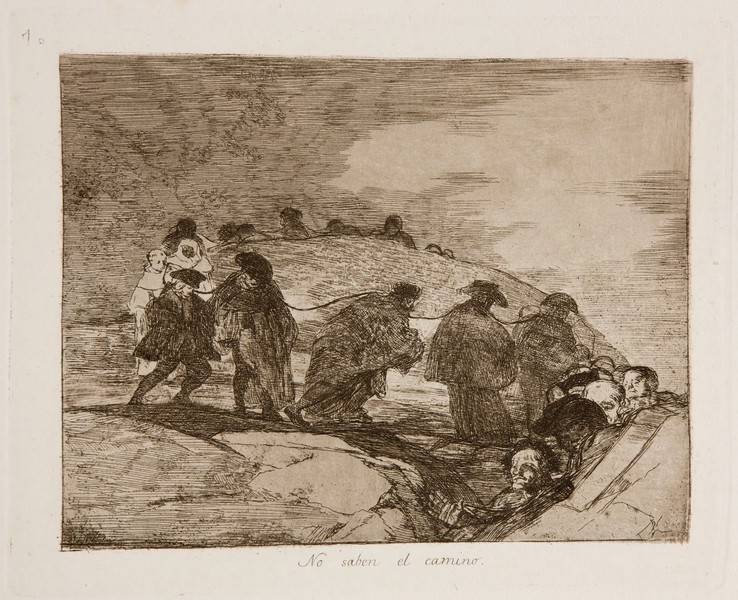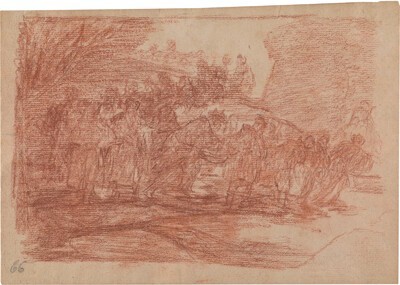- Cronología
- Ca. 1820 - 1823
- Dimensiones
- 177 x 201 mm
- Técnica y soporte
- Etching, burin, drypoint and burnisher
- Reconocimiento de la autoría de Goya
- Undisputed work
- Ficha: realización/revisión
- 02 Dec 2010 / 24 May 2023
- Inventario
- 225
See Sad forebodings of what is to come.
The title of the print was handwritten by Goya and was engraved without any modification to the plate in the first edition produced by the Royal Academy of Fine Arts of San Fernando in Madrid in 1863.
A preparatory drawing of this engraving is in the Prado Museum
From the background of the engraving, tracing an undulating shape, a line of men from all social classes approaches the viewer: priests with tile hats, nobles, humbler characters, etc. They are all linked together by a rope that seems to bind them inextricably. The landscape is barren and their sorrowful faces look down at the ground. In the foreground we can see their guide, who turns out to be a blind man.
This image reminds us of the passage in the Gospel of Matthew (15:15) and Luke (6:39) in which the parable of the blind leading the blind is narrated. This theme had an interesting diffusion in the medieval world and in the Flemish Renaissance; one need only think of the engraving by Cornelius Massys (Antwerp, ca. 1510-1556/1557) in which a blind man tied by a rope leads the way for other blind people. The subject was also treated by Hieronymus Bosch (Bolduque, ca.1450-1516) and Pieter Brueghel the Elder (Breda, 1525-Brussels, 1569). In Spanish literature, the poet Gómez Manrique (Amusco, 1412-Toledo, 1490) had referred to the blind man who guides others, saying: "Los cuerdos fuyr devrían/ de do locos mandan más./ que quando los çiegos guían, !quay de los que van detrás".
During the 18th century, several writers wrote texts that can be related to engraving no. 70. Perhaps the most closely related to the print is that of Bartolomé José Gallardo Blanco (Campanario, Badajoz, 1776-Alcoy, 1852), a friend of Goya's, who wrote on page 19 of his Burlesque Critical Dictionary (1812): "The paths of virtue, if we are to follow them well, must be illuminated by the light of wisdom: understanding guides the will: with blindfolded eyes and a chain at our feet we cannot make a great journey on the road to perfection". On page 13 of the same book he says: "If we can walk in paths of flowers, let us not walk among thorns and thistles".
In short, it could be thought that this engraving refers to the situation of the country after the War of Independence and the coming to power of Ferdinand VII. Thus Spain, represented in the print in all its social classes, became a country in the hands of a monarch guided by the principles of the Ancien Régime, which were far removed from the ideas of the Enlightenment, from the light of reason. Goya probably drew on different literary and formal sources which he fused in this image with a clearly critical content.
Enrique Lafuente Ferrari doubts that the figures parading tied up in the print by the Aragonese painter could be the Spaniards returning from captivity in France who do not know which side to take in what is happening in the country or those who, punished by Ferdinand VII, are on their way to the African prisons.
Nigel Glendinning believes that Goya may have reflected in this print Canto XXVI of the text by Giambattista Casti (Viterbo or Acquapendente, 1724-Paris, 1803) Gli animali parlanti (1801), to which we must refer in order to explain some other prints from the Emphatic Caprices.
The plate is in the National Chalcography (cat. 321).
-
Goya. Das Zeitalter der Revolucionen. Kunst um 1800 (1980 – 1981)Hamburger KunsthalleHamburg1980cat. 95
-
Goya y el espíritu de la IlustraciónMuseo Nacional del PradoMadrid1988from October 6th to December 18th 1988. Exhibited also at Museum of Fine Arts, Boston, January 18th to March 26th 1989; The Metropolitan Museum of Art, Nueva York, May 9th to July 16th 1989, Madrid curator Manuela B. Mena Marqués, scientific directors Alfonso E. Pérez Sánchez and Eleanor A. Sayrecat. 157
-
Francisco Goya. Sein leben im spiegel der graphik. Fuendetodos 1746-1828 Bordeaux. 1746-1996Galerie KornfeldBern1996from November 21st 1996 to January 1997cat. 160
-
Francisco Goya. Capricci, follie e disastri della guerraSan Donato Milanese2000Opere grafiche della Fondazione Antonio Mazzottacat. 150
-
Goya et la modernitéPinacothèque de ParisParís2013from October 11st 2013 to March 16th 2014cat. 109
-
Madrid2017
-
Goya, grabadorMadridBlass S.A.1918cat. 172
-
Goya engravings and lithographs, vol. I y II.OxfordBruno Cassirer1964cat. 190
-
Vie et ouvre de Francisco de GoyaParísOffice du livre1970cat. 1114
-
A solution to the enigma of Goya’s emphatic caprices nº 65-80 of The Disasters of WarApollo1978pp.186-191
-
Goya y el espíritu de la IlustraciónMadridMuseo del Prado1988pp.439-440, cat. 157
-
Catálogo de las estampas de Goya en la Biblioteca NacionalMadridMinisterio de Educación y Cultura, Biblioteca Nacional1996cat. 288
-
ParísPinacoteca de París2013p. 154
-
Goya. In the Norton Simon MuseumPasadenaNorton Simon Museum2016pp. 114-151
-
ZaragozaGobierno de Aragón y Fundación Bancaria Ibercaja2017p. 243

